The 2017 Hyundai Elantra marked a significant step forward in the compact car segment, bringing together a bold design, advanced safety technologies, and enhanced fuel efficiency. Released in January 2016, this model aimed to solidify the Elantra’s position as a value leader in a highly competitive market. Let’s explore the key aspects that made the 2017 Hyundai Elantra a compelling choice for car buyers.
Exterior Design: Confident and Aerodynamic
The exterior of the 2017 Elantra showcases a confident and sculpted design language. Hyundai’s design philosophy of “dynamic precision” is evident in the car’s form, blending aerodynamic efficiency with aesthetic appeal. The designers and engineers collaborated to create a body that is both visually striking and functionally efficient.
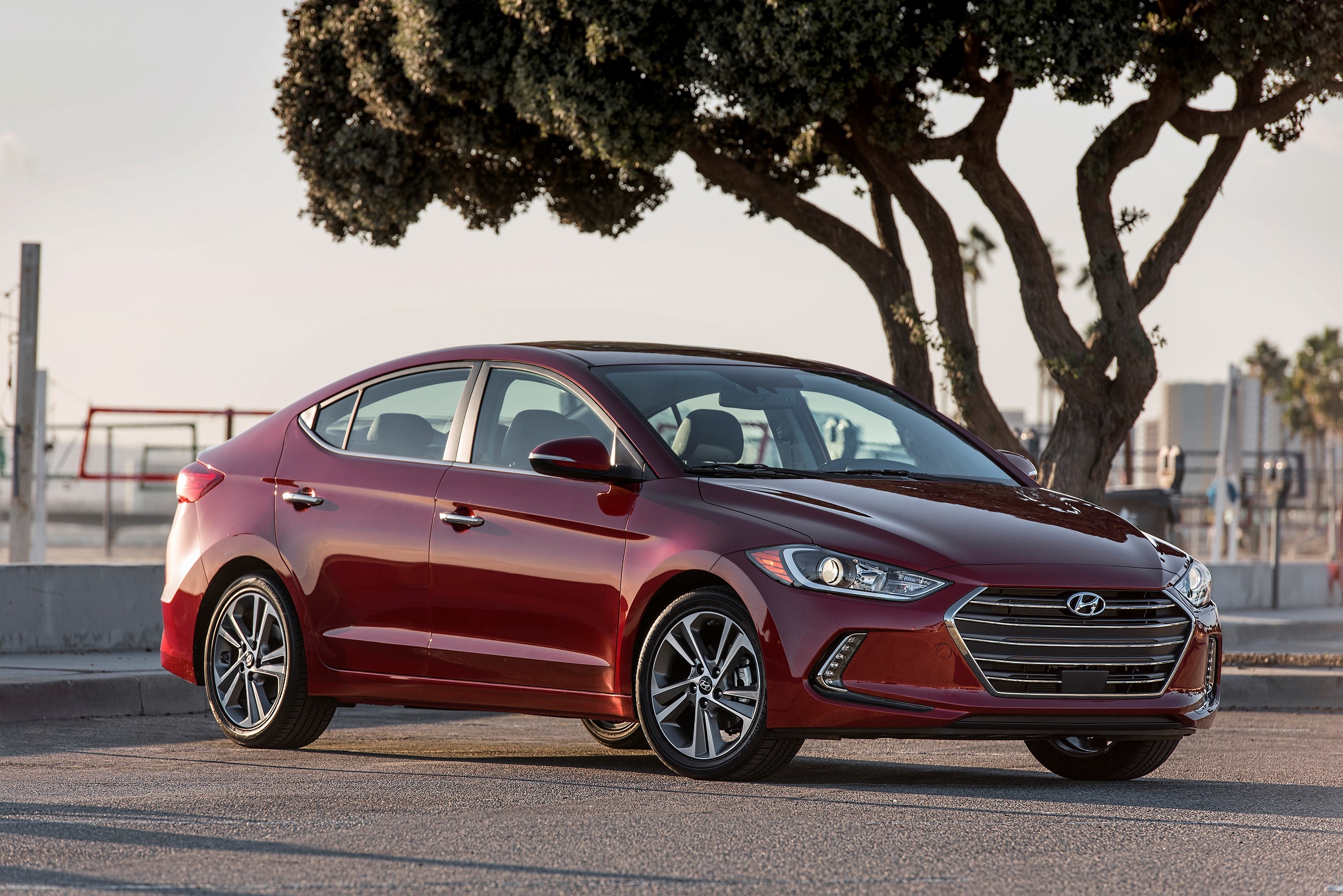 2017 Hyundai Elantra Sedan Front View
2017 Hyundai Elantra Sedan Front View
The front fascia is dominated by Hyundai’s signature hexagonal grille, giving the 2017 Elantra a recognizable and modern face. Available HID headlights with Dynamic Bending Lights and vertical LED daytime running lights further enhance the front’s visual appeal and improve nighttime visibility. A sporty lower front fascia incorporates functional air curtains, inspired by the Sonata Hybrid, to optimize airflow around the front wheels, reducing turbulence and drag. These aerodynamic enhancements, along with underbody covers and a rear bumper spoiler, contribute to an impressive drag coefficient of 0.27.
The side profile of the 2017 Elantra is defined by a sleek character line that accentuates the car’s sweeping silhouette. Available 17-inch alloy wheels, LED door handle approach lights, side mirror LED turn signal indicators, and LED taillights add premium touches to this compact sedan. The 2017 Elantra was offered in a range of eight exterior colors, including five new options. Dimensionally, the car grew slightly, with an increase in both length and width, giving it a more athletic and grounded stance.
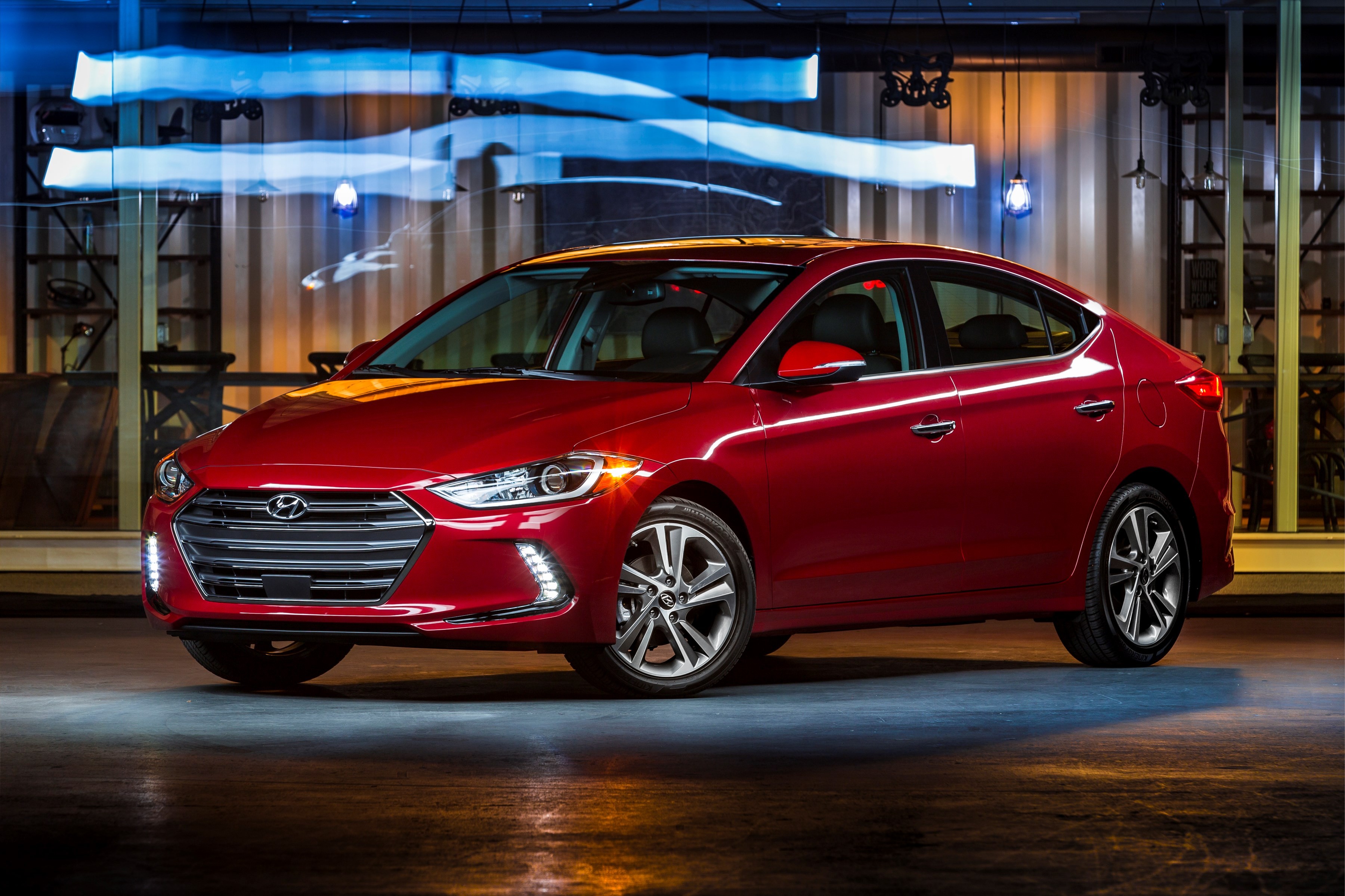 Side profile of the 2017 Hyundai Elantra Sedan showcasing its sleek lines
Side profile of the 2017 Hyundai Elantra Sedan showcasing its sleek lines
Interior Design: Modern, Intuitive, and Spacious
Moving inside, the 2017 Elantra’s interior is designed to be modern, driver-oriented, and intuitive. The focus was on creating a spacious and comfortable environment with high-quality materials and user-friendly technology. Soft-touch materials are strategically placed in key areas, enhancing the tactile experience.
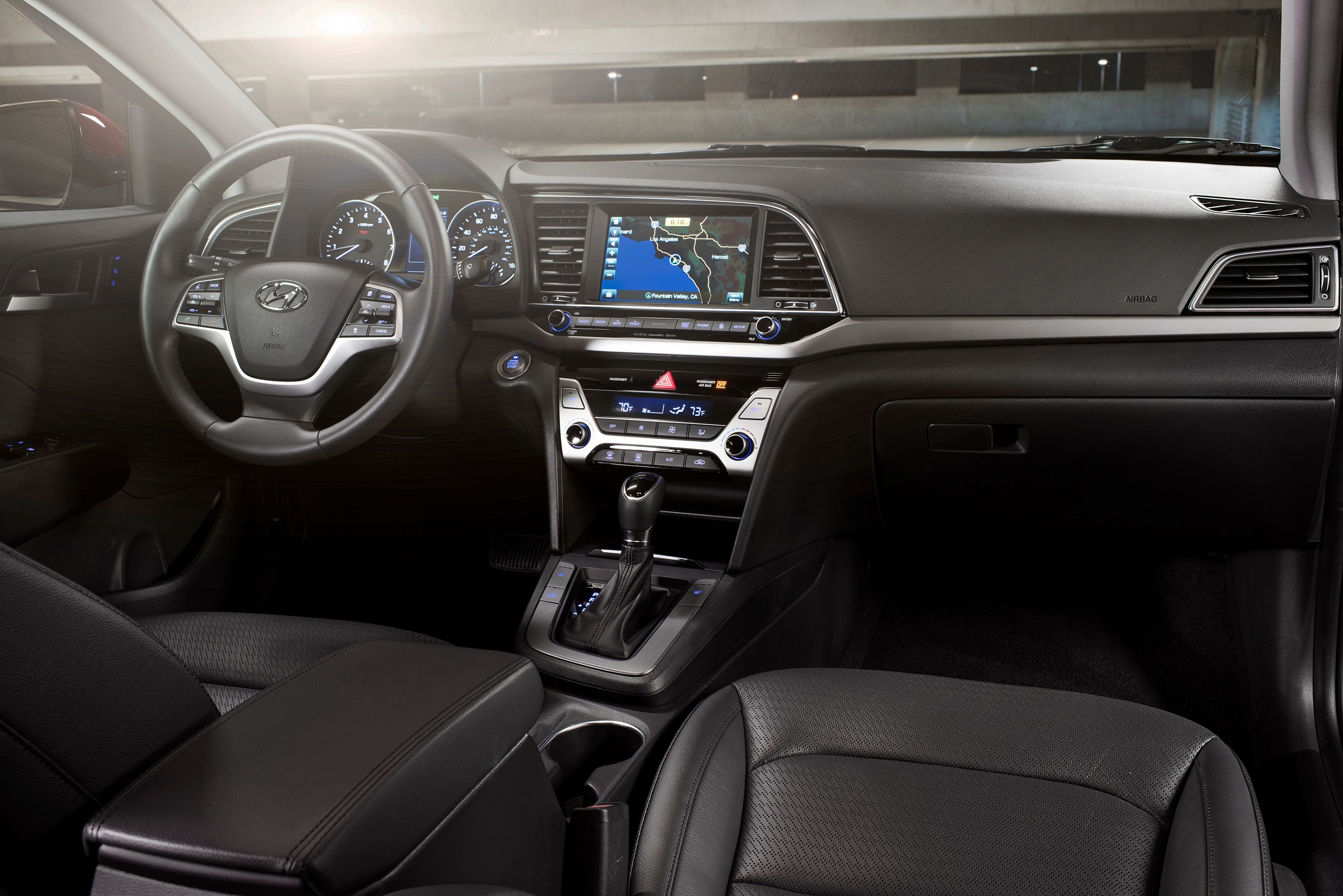 Interior view of the 2017 Hyundai Elantra Sedan showcasing dashboard and seats
Interior view of the 2017 Hyundai Elantra Sedan showcasing dashboard and seats
The instrument panel features a wide design, contributing to a sense of spaciousness. An available 4.2-inch color TFT LCD instrument display improves driver visibility and provides essential vehicle information. The center stack is horizontally oriented, with controls logically grouped by function and angled slightly towards the driver for better ergonomics. Premium convenience features include an integrated memory system for the power driver seat and side mirrors, dual automatic temperature control with auto defogging, and an auto-dimming rearview mirror. Ergonomic front seats, constructed with high-tension lightweight frames and multi-firmness seat pads, enhance comfort, especially on longer drives.
All seats in the 2017 Elantra utilize SoyFoam™, an eco-friendly material incorporating soybean oil. Available heated front and rear seats, along with a 60/40 split-folding rear seat, add to passenger comfort and versatility. Notably, the 2017 Elantra boasts class-above interior volume, classified as a midsize car by the EPA due to its generous 110.2 cu. ft. of total interior space, surpassing some competitors in the compact segment and even rivaling some premium models in interior roominess.
Chassis and Ride: Refined and Responsive
Hyundai engineers prioritized ride comfort and noise reduction in the 2017 Elantra. The chassis is lighter yet more rigid, utilizing 53 percent advanced high-strength steel, a significant increase from the previous generation. This enhanced rigidity, along with increased structural adhesive application, contributes to improved torsional rigidity and bending strength. These enhancements translate to better ride and handling, reduced cabin noise, and improved durability.
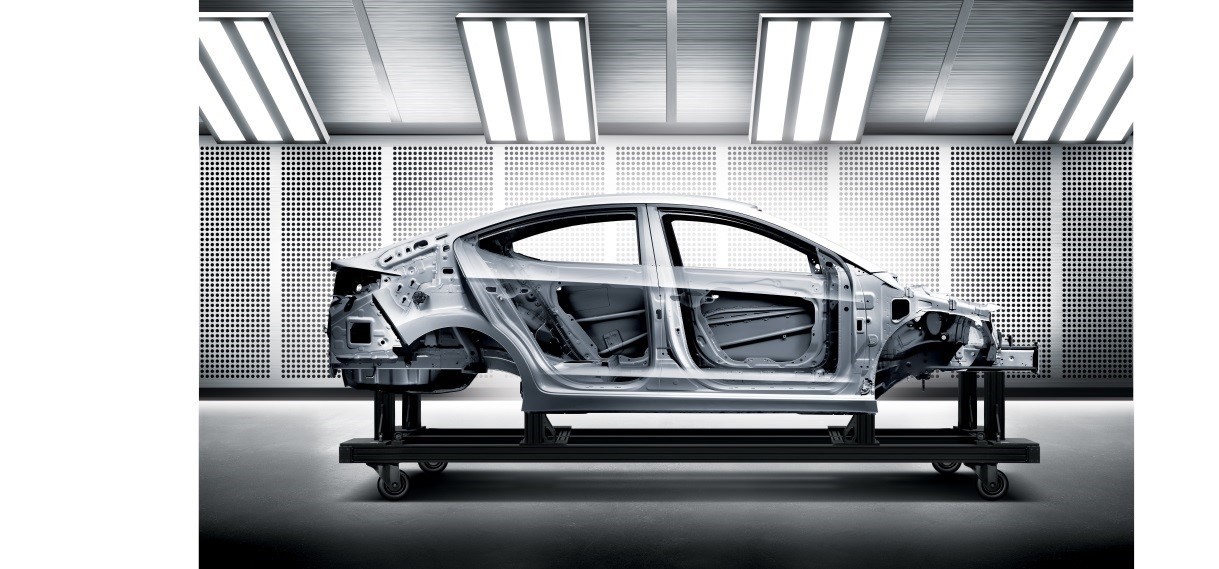 The chassis of the 2017 Hyundai Elantra highlighting structural components
The chassis of the 2017 Hyundai Elantra highlighting structural components
To minimize cabin noise, the 2017 Elantra incorporates a hood insulator, reduced aperture size in the dash panel, thicker front door glass, and sound-absorbing materials throughout the vehicle. Chassis refinements include redesigned rear suspension geometry, modifying shock absorber angles and coil spring positions, and increased rear bushing diameter for enhanced durability. The front suspension utilizes McPherson struts and gas shock absorbers, along with a stabilizer bar for improved handling. The Motor-Driven Power Steering (MDPS) system provides responsive steering and contributes to fuel efficiency.
Powertrain Options: Efficient and Engaging
The 2017 Hyundai Elantra offered two new powertrain options focused on efficiency and drivability. The standard engine for SE and Limited trims is a 2.0-liter Nu MPI Atkinson four-cylinder engine. This engine produces 147 horsepower and 132 lb. ft. of torque. The Atkinson cycle design, combined with multi-port injection, enhances fuel efficiency. Other engine enhancements include intermediate valve cam phasing, high energy ignition coils, an electronically controlled thermostat, and piston cooling jets. This engine is paired with either a six-speed manual transmission (SE trim only) or a next-generation six-speed automatic transmission, both contributing to improved fuel economy.
For the Elantra Eco trim, a 1.4-liter Kappa turbocharged GDI four-cylinder engine is available. This engine delivers 128 horsepower and a robust 156 lb-ft. of torque at low RPMs. Mated to a seven-speed dual-clutch transmission (EcoShift), this powertrain prioritizes fuel efficiency, with projected combined fuel economy ratings of up to 35 mpg. Features of this engine include an integrated cylinder head and exhaust manifold, optimized intake port, a single scroll turbocharger with an electric wastegate actuator, and high-pressure fuel injectors.
Both engine options in the 2017 Elantra benefit from friction-reducing and cooling technologies. All trims also include Drive Mode Select, allowing drivers to choose between Eco, Normal, and Sport modes to adjust powertrain and steering feel.
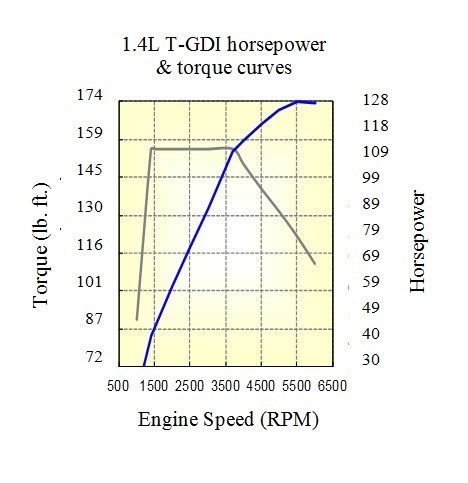 The 2017 Hyundai Elantra engine bay showcasing the powertrain
The 2017 Hyundai Elantra engine bay showcasing the powertrain
Safety and Advanced Driver Assistance Systems
Safety was a paramount concern in the development of the 2017 Elantra. Beyond the strengthened chassis, structural improvements include hexagonal front side members, reinforced dash-to-cowl connection, and hot stamping applications in key areas. B-pillar assemblies are designed with partial softening hot stamping to better absorb side impacts. Dual impact beams are incorporated into the rear doors.
Standard safety features include a seven-airbag system with a new driver’s knee airbag, Electronic Stability Control, Vehicle Stability Management, Traction Control, ABS, and a Tire Pressure Monitoring System. The 2017 Elantra was expected to achieve top safety ratings from both the IIHS and NHTSA.
The 2017 Elantra also offered a suite of advanced safety technologies, often found in luxury vehicles. Available Automatic Emergency Braking with class-exclusive Pedestrian Detection utilizes radar and camera fusion to detect vehicles and pedestrians and can automatically apply brakes to prevent or mitigate collisions. Additional available safety features include Lane Departure Warning, Lane Keep Assist System, Blind Spot Detection with Rear Cross-traffic Alert and Lane Change Assist, and a rearview camera with dynamic guidance.
Intelligent Technology and Connectivity
The 2017 Elantra stands out in its class with innovative technology features designed to enhance convenience and driver confidence. A segment-exclusive hands-free Smart Trunk allows for easy trunk opening when approaching the vehicle with the key fob. Available Dynamic Bending Light and Smart Cruise Control further enhance the driving experience. Dynamic Bending Lights improve nighttime visibility by turning the headlights with the steering wheel, and High Beam Assist automatically manages high beam usage. Smart Cruise Control maintains a set distance from the vehicle ahead, adjusting speed as needed.
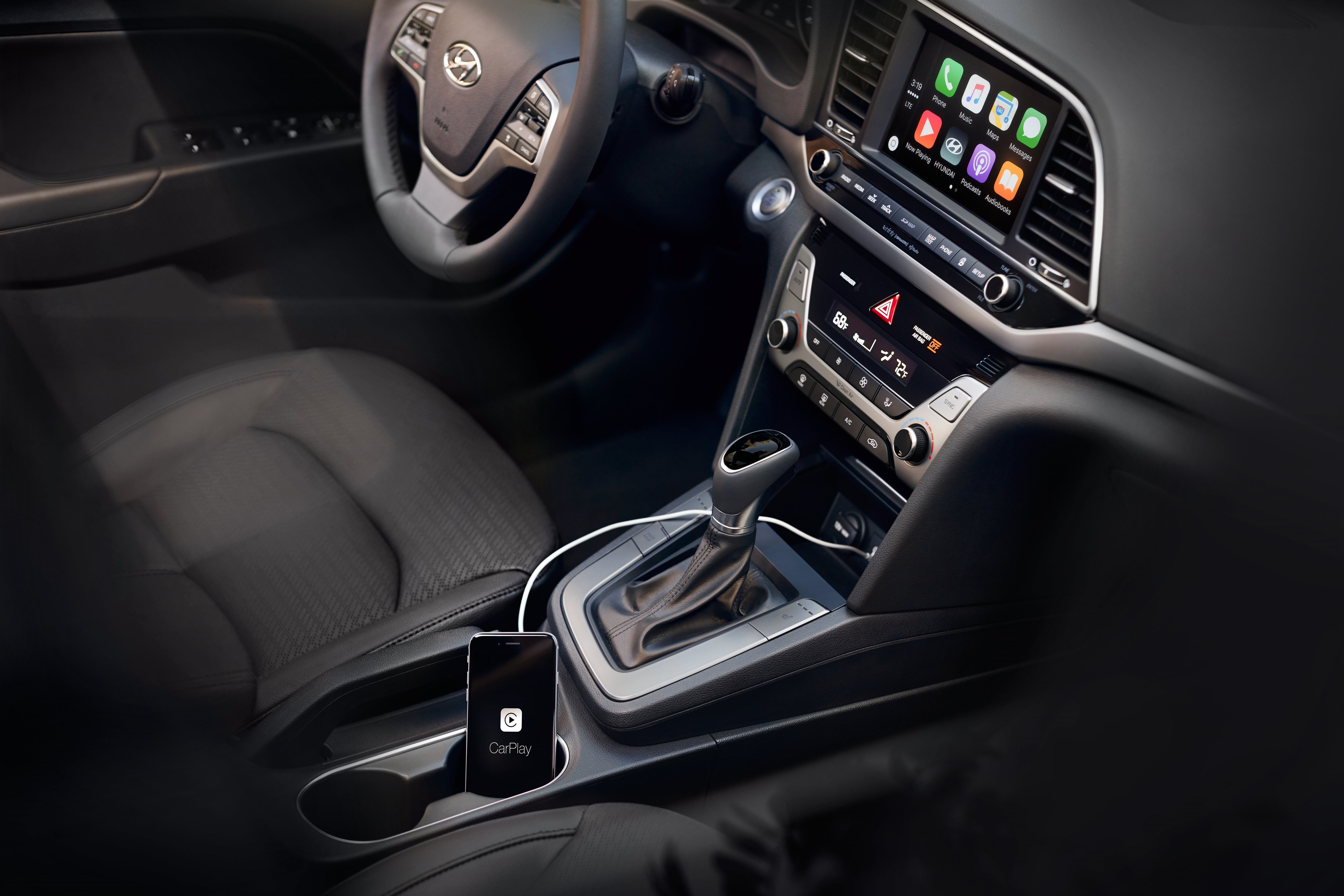 The 2017 Hyundai Elantra interior showcasing the infotainment system with Apple CarPlay
The 2017 Hyundai Elantra interior showcasing the infotainment system with Apple CarPlay
For connectivity, all 2017 Elantras come standard with iPhone®/USB and auxiliary input jacks and SiriusXM® satellite radio. Available infotainment systems include a 7.0-inch Display Audio touchscreen system with rearview camera and an 8.0-inch navigation system. Both systems support Apple® CarPlay and Android® Auto for seamless smartphone integration. The 8.0-inch navigation system features enhanced display, SiriusXM® Satellite Radio and HD Radio® Technology, Pandora® capability, SiriusXM® Travel Link®, and “Eyes Free” Siri integration. For premium audio, an eight-speaker Infinity system with Harman’s Clari-Fi™ music restoration technology is available.
Blue Link® Connected Car System
The 2017 Elantra offered Hyundai’s next-generation Blue Link system, providing enhanced safety, service, and infotainment telematics. Features include Remote Start w/ Climate Control, Destination Search powered by Google®, Remote Door Lock/Unlock, Car Finder, Enhanced Roadside Assistance, and Stolen Vehicle Recovery. Blue Link can be accessed via rearview mirror buttons, web, or smartphone app, and is even compatible with Android Wear™ and Apple Watch™ smartwatches. Blue Link is offered in Connected Care & Remote packages standard for one year, and Guidance package for navigation-equipped models.
Conclusion: The 2017 Hyundai Elantra – A Smart Choice
The 2017 Hyundai Elantra successfully combined a striking new design with a host of advanced features, enhanced safety, and efficient powertrains. It continued the Elantra’s tradition of offering exceptional value in the compact car segment while stepping up its game with segment-first technologies and a more refined driving experience. For those seeking a well-rounded, feature-rich, and economical compact sedan, the 2017 Hyundai Elantra remained a compelling option.
